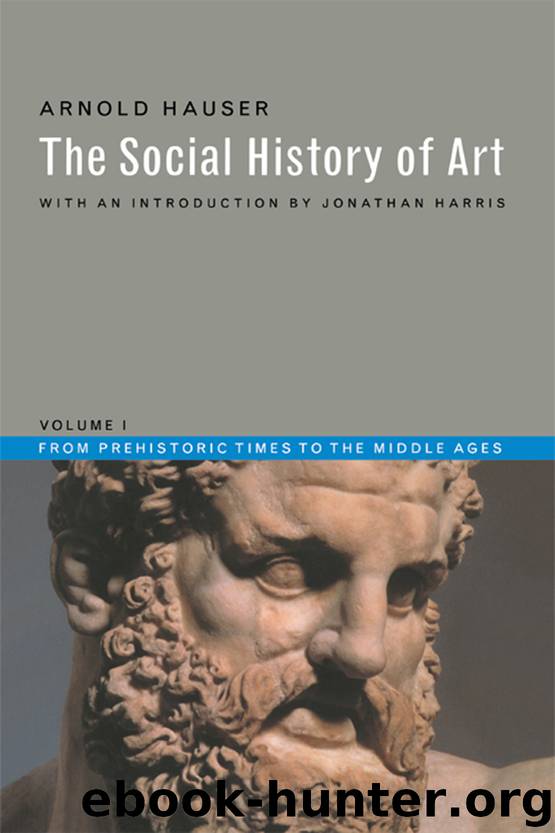Social History of Art, Volume 1 by Hauser Arnold; Harris Jonathan; Harris Jonathan

Author:Hauser, Arnold; Harris, Jonathan; Harris, Jonathan
Language: eng
Format: epub
Publisher: Routledge
3.
CAUSES AND CONSEQUENCES OF ICONOCLASM
The wasteful wars of the sixth, seventh and eighth centuries, which required the co-operation of the landed gentry in order to keep the army up to strength, confirmed the power of the landowners and led even in the East to a kind of feudalism. It is true that the mutual dependence of feudal lord and vassal which marked the Western feudal system was lacking here, but even here the Emperor became more or less dependent on the landowners as soon as he no longer had at his disposal the means necessary for the raising of a mercenary army.21 The system of bestowing landed property as compensation for military service developed, however, only on a small scale in the Eastern Roman Empire. In contrast to the West, not the magnates and knights but the peasants and the common soldiers were enfeoffed here. The owners of latifundia, naturally, tried to absorb the estates owned by peasants and soldiers which arose in this way, as they had done in the West with freehold peasant property, and here too the peasants went for protection from the often intolerable burden of taxation to the great lords, as they had to in Western Europe because of the insecurity of their tenure. For their part, at least in the early stages, the Emperors made every possible effort to prevent the accumulation of landed property, above all, of course, in order not to fall into the powerful hands of the great landowners themselves. But their main effort during their long and desperate fight against the Persians, the Avars, the Slavs and Arabs was concentrated on the preservation of the army; every other consideration had to yield to this one overriding concern. The prohibition of image-worship was only one of their emergency measures.
Iconoclasm was really not a movement inimical to art: it did not persecute art as such but only a special kind of art; it merely fought against pictures with a religious content, and even in the period of the most rabid persecution, decorative paintings were still tolerated. The campaign had in the main a political background; the attack on art as such was a comparatively insignificant undercurrent in the total complex of motives— perhaps the least significant of all. In those places where the movement started, in any case, it played the smallest possible part even though it had a not altogether inconsiderable share in spreading the idea of iconoclasm. The aversion from the pictorial representation of the numinous, as well as the dislike for anything reminiscent of idolatry, was by no means so decisive an influence on the outlook of the later Byzantines, with their delight in pictures, as on that of the early Christians. Until the time when Christianity was recognized by the State, the Church had attacked the religious use of pictures on principle and only tolerated them in cemeteries under certain specific conditions. But even here portraits were prohibited, sculpture was shunned and paintings restricted to symbolical representations. In the churches the use of works of fine art was absolutely forbidden.
Download
This site does not store any files on its server. We only index and link to content provided by other sites. Please contact the content providers to delete copyright contents if any and email us, we'll remove relevant links or contents immediately.
The Secret History by Donna Tartt(18163)
Red Sparrow by Jason Matthews(5196)
Harry Potter 02 & The Chamber Of Secrets (Illustrated) by J.K. Rowling(3556)
In a Sunburned Country by Bill Bryson(3368)
Drawing Cutting Edge Anatomy by Christopher Hart(3290)
Figure Drawing for Artists by Steve Huston(3272)
The Daily Stoic by Holiday Ryan & Hanselman Stephen(3110)
Harry Potter and the Prisoner of Azkaban (Book 3) by J. K. Rowling(3109)
Japanese Design by Patricia J. Graham(3000)
The Roots of Romanticism (Second Edition) by Berlin Isaiah Hardy Henry Gray John(2820)
Make Comics Like the Pros by Greg Pak(2758)
Stacked Decks by The Rotenberg Collection(2687)
Harry Potter and the Deathly Hallows (7) by J.K. Rowling(2550)
Draw-A-Saurus by James Silvani(2504)
Tattoo Art by Doralba Picerno(2487)
On Photography by Susan Sontag(2482)
Foreign Devils on the Silk Road: The Search for the Lost Treasures of Central Asia by Peter Hopkirk(2388)
Churchill by Paul Johnson(2364)
The Daily Stoic by Ryan Holiday & Stephen Hanselman(2344)
